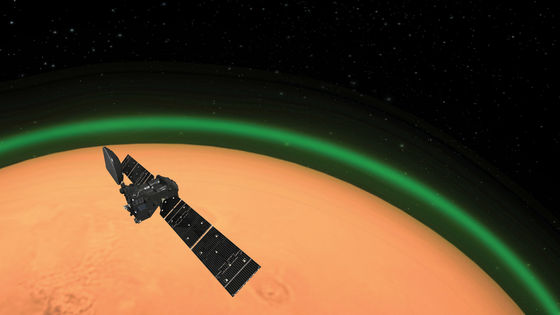Astronauts on Mars may see 'green skies'

The sky appears blue because short-wavelength blue light is scattered more strongly by particles in the atmosphere, spreading across the sky and reaching our eyes. Mars also has an atmosphere, and when we look up at the sky from Mars, we see light scattered by particles in the atmosphere. However, researchers from
Observation of the Mars O2 visible nightglow by the NOMAD spectrometer onboard the Trace Gas Orbiter | Nature Astronomy
https://www.nature.com/articles/s41550-023-02104-8
ESA - A green glow in the martian night
https://www.esa.int/Science_Exploration/Human_and_Robotic_Exploration/A_green_glow_in_the_martian_night

Astronauts on Mars may see a green sky, eerie new study suggests | Live Science
https://www.livescience.com/space/mars/astronauts-on-mars-may-see-a-green-sky-erie-new-study-suggests
ESA is conducting the Trace Gas Orbiter (TGO) mission in collaboration with Russian agencies to search for evidence of methane and other atmospheric trace gases that may be signs of active biological and geological processes on Mars. TGO sent an atmospheric probe and a landing demonstration module called Schiaparelli EDM to Mars in 2016. Although Schiaparelli EDM crashed to the surface and failed to land, it continues to study the atmosphere.
ESA has detected a 'green night sky' in the Martian atmosphere for the first time as part of the TGO mission around October 2023. Although it was expected that nightlight would be visible on Mars, this is the first time it has been observed in visible light. According to ESA, the green night sky could be bright enough for a spacecraft to operate at night.
ESA explains how the atmosphere creates the glow: First, about 50 km above the planet's surface, carbon dioxide molecules receive energy from sunlight and are split into oxygen atoms. When two oxygen atoms combine to form oxygen molecules, sunlight is scattered.

When oxygen atoms move away from sunlight, that is, to the night side, they lose energy from the sun and gather at lower altitudes, diffusing the light. 'This radiation is caused by oxygen atoms that are produced in the summer atmosphere, are carried by the wind, and then recombine. When they move, they radiate at altitudes of about 40 to 60 km in the Martian atmosphere, at higher latitudes in winter than in summer,' explains Laurie Soret, a researcher at the Institute of Atmospheric and Planetary Physics at the University of Liège in Belgium.

The TGO probe orbited Mars at an altitude of 400 km and observed the night side of Mars using a channel that detects visible light, revealing a green light that spread across the planet. ESA has shown the following artist's impression of the probe's image of the atmosphere reflecting green light.

'These new observations are unexpected and of interest for future Mars exploration,' Jean-Claude Gérard, a planetary scientist at the University of Liège, said in an ESA statement. 'The intensity of the glow is such that simple, relatively cheap instruments in Mars orbit could measure and monitor the atmospheric currents. Future ESA missions could carry cameras to image the whole of Mars. Furthermore, the radiation is strong enough that we can predict that future astronauts will be able to observe it during the polar night from orbit or on the Martian surface.'
Related Posts:
in Science, Posted by log1e_dh







